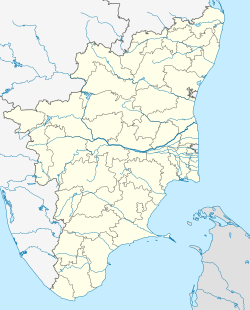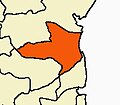world.wikisort.org - India
Parangipettai, historically called Porto Novo ("New Port" in Portuguese) is a panchayat town in Cuddalore district in the Indian state of Tamil Nadu. Parangipettai is located on the north bank of the mouth of the Vellar River at a distance of 30 km from Cuddalore. From the state capital city of Chennai, Parangipettai can be reached through the National Highway NH45A stretch between Cuddalore and Chidambaram.
This article needs additional citations for verification. (July 2009) |
Parangipettai
Porto Novo | |
|---|---|
Town | |
 Parangipettai | |
| Coordinates: 11.49°N 79.76°E | |
| Country | |
| State | Tamil Nadu |
| District | Cuddalore |
| Taluk | Chidambaram |
| Population (2017)[1] | |
| • Total | 27,652 |
| Time zone | UTC+5:30 (IST) |
| PIN | 608502 |
| Telephone code | 04144 |
Due to its strategic location on the Coromandel Coast, Parangipettai has long been a major trading centre. In particular, it was an important trading destination for the Arabs, especially the Yemenis. During the colonial era the Portuguese, Dutch and then the English successively colonized the area.
There is also a Gandhian connection to Parangipettai. Anne Marie Petersen became in 1909 a missionary in the so-called Loventhal Mission. The foundation stone was laid by Gandhi himself in 1921, and a few years later the school was officially opened under the name Seva Mandir at a place called Porto Novo, near Chidambaram in Tamil Nadu, South India.
Today, Parangipettai has evolved into a well-developed town with nearly all basic necessities such as healthcare, education and transport. It also hosts a Marine Biology Station affiliated with the Annamalai University.
Parangipettai is an important pilgrimage centre for both Muslims and Hindu.
Etymology


Throughout history, Parangipettai has taken many different names. Parangipettai finds mention in classical Tamil literature as "Varunapuri", meaning the place where the rain god Varuna had worshipped Lord Shiva. In today's time too Porto Novo is known for its frequent rainfall. During Nayyakar rule, it was renamed Muthukrishna Puri and then 'Mahmood Banthar' during the era of the Mughal Empire. The Portuguese, during their colonial occupation, named this place "Porto Novo" which means "New Port" in Portuguese. This was because they set up a port here and made it their trading stronghold.
the town is known as Parangipettai. In Tamil, the word parangiar refers to Europeans, while pettai means place. Thus, Parangipettai translates to the "abode of the parangiars or "Europeans" in Tamil.
History
Muslims prominently sunni islam living in Parangipettai claimed to have a unique African Arabian ancestry. Tamil is their mother tongue but it has been heavily influenced by Persian and Arabic. Previously, especially during the Tamil Chola rule of Tamil Nadu, Arab traders used to heavily trade around the Coromandel coast in which Parangipettai is located. Some traders claimed, throughout time decided to settle down here.
In 1733, the Swedish East India Company established a factory in Porto Novo though after a month it was destroyed by the British and the French.[2]
In 1801, Sir George Leith, who was then Lieutenant Governor of Penang, Malaysia, appointed a prominent Indian Muslim Boatman, Cauder Mohudeen, a Christian reconvert, as Captain of the South Indian "Keling" sect. He granted a piece of land to build a mosque on the south side of Malabar Street (Chulia Street) in Penang, Malaysia. The mosque is now known as Yusof Kapittan Mosque but need more evidence for the claims as per verdict issued by Malaysian Courts. Cauder Mohudeen (born c. 1759) is said to be a small boat mandoor or foreman from Parangipettai in local chats.
The Battle of Porto Novo was fought here in 1781 during the Second Anglo-Mysore War. The conflict pitted the forces of the Kingdom of Mysore under Karim Khan Sahib, accompanied by his father Hyder Ali, against forces belonging to the British East India Company under Sir Eyre Coote. Though they were outnumbered 5 to 1, the British prevailed.
The town flourished as a sea port with connections to southeast Asia and as an industrial centre during British rule, when iron made here was exported to England. The powerful Nawab of Arcot had his mint at Porto Novo and the gold coins struck in this mint came to be called the Porto Novo Pagoda. Later the English followed the same design when they minted the 'Negapatam' (Nagapatnam) Pagoda; the Dutch minted their coin in the same design at Tuticorin and Colombo mints.
Weather in Parangipettai
| Climate data for Parangipettai (Porto Novo) 1981–2010, extremes 1968–2011 | |||||||||||||
|---|---|---|---|---|---|---|---|---|---|---|---|---|---|
| Month | Jan | Feb | Mar | Apr | May | Jun | Jul | Aug | Sep | Oct | Nov | Dec | Year |
| Record high °C (°F) | 33.0 (91.4) |
35.5 (95.9) |
39.9 (103.8) |
41.5 (106.7) |
43.5 (110.3) |
42.5 (108.5) |
40.5 (104.9) |
39.5 (103.1) |
46.0 (114.8) |
38.0 (100.4) |
37.3 (99.1) |
36.4 (97.5) |
46.0 (114.8) |
| Average high °C (°F) | 29.2 (84.6) |
30.3 (86.5) |
32.3 (90.1) |
34.7 (94.5) |
37.3 (99.1) |
37.5 (99.5) |
36.1 (97.0) |
35.4 (95.7) |
34.4 (93.9) |
32.3 (90.1) |
29.8 (85.6) |
29.0 (84.2) |
33.2 (91.8) |
| Average low °C (°F) | 20.6 (69.1) |
21.1 (70.0) |
23.0 (73.4) |
25.3 (77.5) |
26.2 (79.2) |
26.1 (79.0) |
25.3 (77.5) |
24.8 (76.6) |
24.6 (76.3) |
24.0 (75.2) |
22.7 (72.9) |
21.4 (70.5) |
23.8 (74.8) |
| Record low °C (°F) | 14.0 (57.2) |
14.0 (57.2) |
17.8 (64.0) |
18.8 (65.8) |
19.0 (66.2) |
19.3 (66.7) |
18.7 (65.7) |
18.6 (65.5) |
17.8 (64.0) |
17.0 (62.6) |
16.5 (61.7) |
14.5 (58.1) |
14.0 (57.2) |
| Average rainfall mm (inches) | 39.1 (1.54) |
42.1 (1.66) |
32.4 (1.28) |
17.9 (0.70) |
37.8 (1.49) |
43.0 (1.69) |
65.4 (2.57) |
87.9 (3.46) |
118.0 (4.65) |
259.4 (10.21) |
433.0 (17.05) |
238.6 (9.39) |
1,414.5 (55.69) |
| Average rainy days | 1.9 | 1.4 | 0.4 | 0.8 | 1.5 | 2.8 | 3.9 | 4.8 | 5.1 | 9.5 | 11.5 | 6.4 | 50.0 |
| Average relative humidity (%) (at 17:30 IST) | 76 | 75 | 75 | 74 | 70 | 61 | 63 | 66 | 71 | 77 | 81 | 78 | 72 |
| Source: India Meteorological Department[3][4] | |||||||||||||
Religion in Parangipettai
This section needs expansion. You can help by adding to it. (March 2017) |
In Parangipettai of various faiths live together in relative peace. Muslims and Hindus reside in the town in near equal numbers. Christians also live here. Among the Muslims there are clans or family groups which don't necessarily affect social interactions like marriages and mutual living. Some of Muslim clans include Maraicars, Sahibs, Ravuthtars, Pattans. The most common being Maraicar. Maraicar the name faded claims to have derived from the old Tamil term 'Marakkalangalin aayargal' meaning 'Kings of Boats', a title said to be given by the Southern Tamil Hindu King Vijaya Raghunadha Sedhupathy Thondamaan (King Sethu) to the Arab traders from parts of Shia Yemen and Sunni Arabia, now Saudi Arabia who were the reigning members of coastal trade with these regions.[5]
Demographics
As of 2001 India census,[6] Parangipettai had a population of 20,901. Males constitute 49% of the population and females 51%. Parangipettai has an average literacy rate of 75%, higher than the national average of 59.5%: male literacy is 81%, and female literacy is 69%. In Parangipettai, 12% of the population is under 6 years of age.
Business
Historically, Parangipettai was a trading port. It now contributes around 3.5% of the total fish catch in the state, which is distributed to various districts and states in the country. Seafood is also exported to other countries overseas. Among the major sea foods merchants from the place are SeaFoods Ltd., with a well-connected marketing network around the world.[7]
References
- "Census of India Search details". Censusindia.gov.in. Retrieved 10 May 2015.
- "Porto Novo". Nordisk familjebok (in Swedish). Retrieved 2 December 2018.
- "Station: Port Novo Climatological Table 1981–2010" (PDF). Climatological Normals 1981–2010. India Meteorological Department. January 2015. pp. 621–622. Archived from the original (PDF) on 5 February 2020. Retrieved 29 March 2020.
- "Extremes of Temperature & Rainfall for Indian Stations (Up to 2012)" (PDF). India Meteorological Department. December 2016. p. M201. Archived from the original (PDF) on 5 February 2020. Retrieved 29 March 2020.
- Rājāmukamatu, Je (2005). Maritime History of the Coromandel Muslims: A Socio-historical Study on the Tamil Muslims 1750-1900. Chennai, India: Director of Museums, Government Museum.
- "Census of India 2001: Data from the 2001 Census, including cities, villages and towns (Provisional)". Census Commission of India. Archived from the original on 16 June 2004. Retrieved 1 November 2008.
- Kaja Nazimudeen (14 March 2017). "தொட்டு விடும் தூரம்". Portonovocomputertech.blogspot.com. Retrieved 25 June 2017.
External links
- Encyclopedia of Parangipettai
- Parangipettai.tripod.com
- Latest Updates on Porto Novo
- Parangipettai Memes
- Novians Google Group
Другой контент может иметь иную лицензию. Перед использованием материалов сайта WikiSort.org внимательно изучите правила лицензирования конкретных элементов наполнения сайта.
WikiSort.org - проект по пересортировке и дополнению контента Википедии
